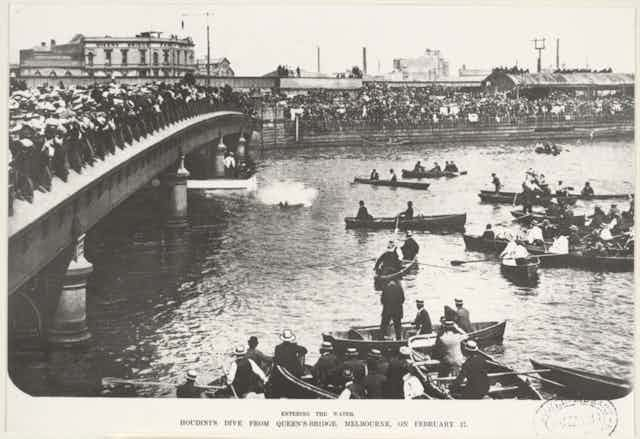Australia is world-famous as a swimming nation. We have a celebrated beach culture, not to mention more privately owned pools per person than any other country. Yet few urban Australians would consider swimming in their city’s river.
Almost every major Australian city sits on the banks of a large river. But judging by online reactions to the suggestion of a dip in the Brisbane River, most people are worried about everything from ear infections to a painful death from brain-eating amoebae.
Melbourne’s Yarra River has been the butt of many jokes, most famously when Norman Gunston extolled its virtues as the river where you could go fishing and land a catch pre-wrapped in newspaper. In Sydney and Perth people just prefer the beach.

It wasn’t always like this. Our modern distaste for river swimming is a stark constrast with a history where urban rivers provided a venue for sport, recreation and entertainment – all within easy distance of shops, offices and public transport.
There were clubs such as the North Adelaide District Swimming Club, formed in 1905, and open water swimming competitions such as those held on Perth’s Swan River from 1912. The Yarra River’s three-mile swim was held from 1917 to 1964, and at its peak was the largest open water swimming competition in the World.
There was spectacle as well as sport, with feats of aquatic derring-do that made swimming look like vaudeville theatre. In the Yarra, Annette Kellerman – one of the first women to reject pantaloons in favour of a one-piece bathing costume – swam her way to a world record between Church Street bridge and Princes Bridge in 1904. After leaving Australia she developed her own swimwear line and went on to become an author and renowned Hollywood actress. The Yarra was her unlikely springboard to global celebrity.

Endurance was similarly tested by “Professor” Alec Lamb in 1907 who swam 7 miles (11km) and dove from eight bridges, stopping for sustaining glasses of milk and whisky from his trainer’s boat. As the Argus newspaper faithfully noted, the first of his bridge dives was so high that the force of the impact tore off his swimming costume. Harry Houdini also famously attracted a crowd of 20,000 to watch him emerge triumphant from chains, handcuffs and the Yarra mud in 1910.
Melbourne’s river even hosted innovative fund-raising events. In 1910 the Royal Life Saving Society used it to stage a fake near-drowning, with a society member throwing himself off Princes Bridge before being “rescued” by a “policeman”. A third member then produced a megaphone to request donations from the concerned crowd of onlookers.
An arguably less brazen charity appeal centred on Solomon Islands swimmer Alick Wickham’s record-breaking dive of 250 feet (76m) into the river in 1917, attracting 50,000 spectators with the proceeds going to the Soldiers Amelioration Fund.
Several lengths behind
Some projects are now aiming to recast Australia’s urban rivers as fun places to swim, including Our Living River in Sydney’s Parramatta River, and the Swim Thru Perth open water swimming event to be held in the Swan River. Meanwhile, the Yarra Swim Co. is planning to revive the three-mile race and build a river-fed swimming pool on the Yarra’s banks.
Fears about pollution are understandable, but can be managed by websites such as Yarra Bay Watch and the New South Wales Office of Environment Health . While important, the official advice inadvertently adds to the view that Australian urban rivers are little more than an extension of the stormwater system.
Compare that with the renaissance of river swimming internationally. British writer Caitlin Davies swam of the length of London’s Thames to uncover a multitude of present and historical swimming cultures. And municipal governments in Copenhagen, Portland, Berlin, New York and Boston have all embraced river swimming.
The Swiss must surely be the world leaders, even advocating for river swimming in international diplomacy. Every year, large Swiss cities host mass swimming events like the Rhineschwimmen in Basel.
As the Swiss have already realised, to swim in an urban river is to reclaim, one stroke at a time, a public space and a wilder romantic past. It is no coincidence that the same country that zealously promotes urban river and lake swimming can also lay claim to a distinguished environmental record. Our regular, primary contact with this most primal of elements can act in a way to force change in the way our rivers are managed, helping both people and the environment to be a bit healthier.
This article was coauthored by Sally McPhee, based on her honours thesis for RMIT’s Bachelor of Urban and Regional Planning.

